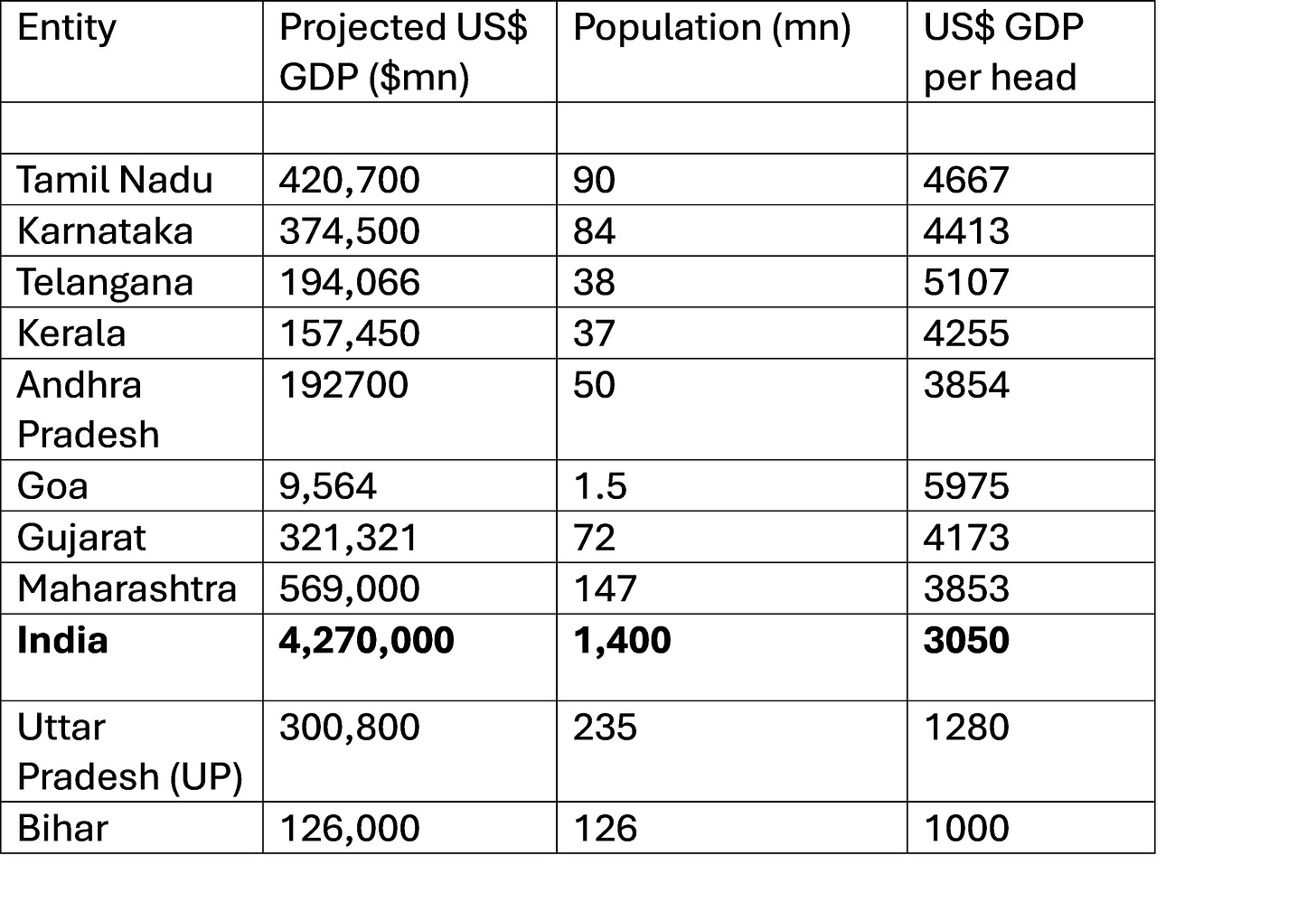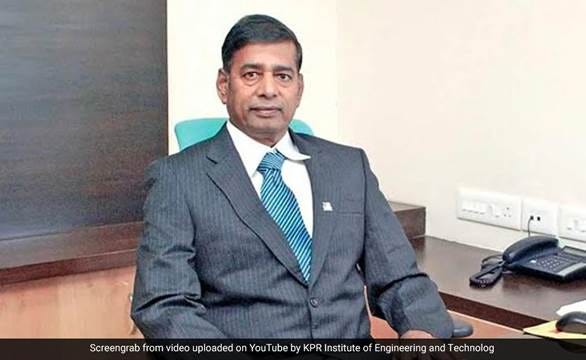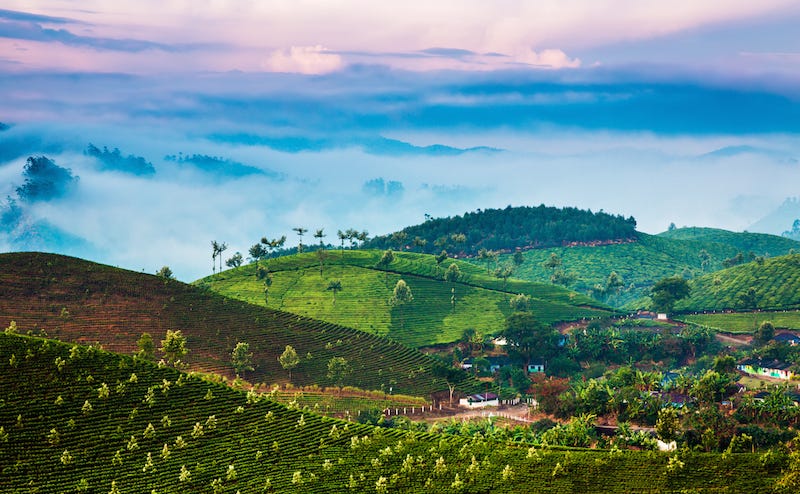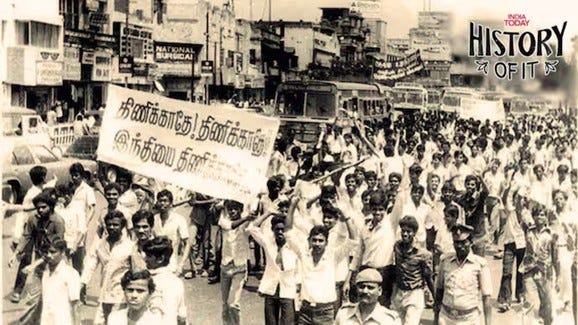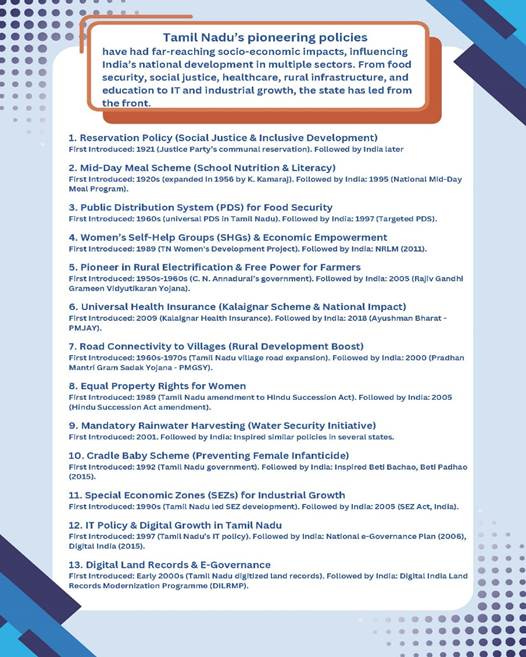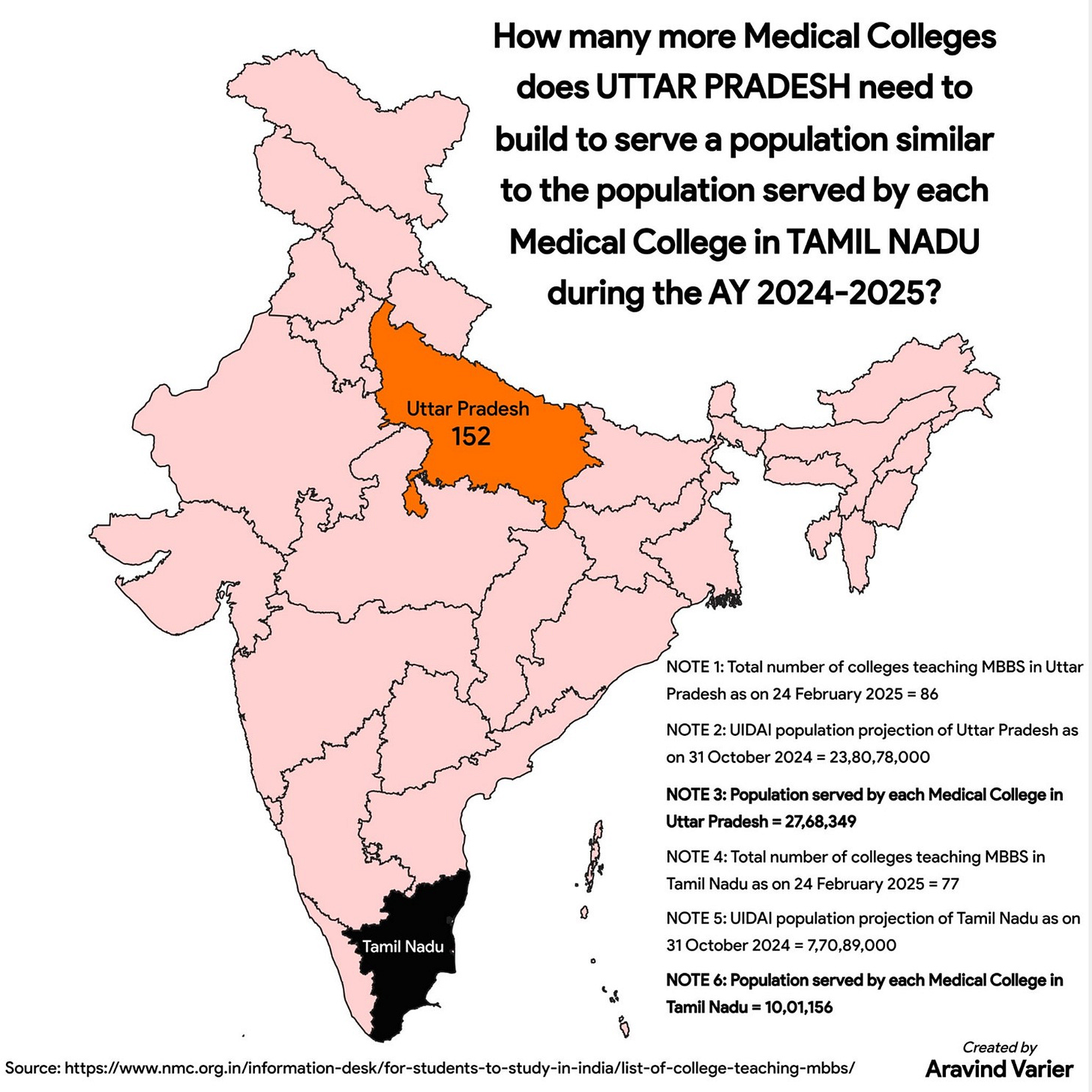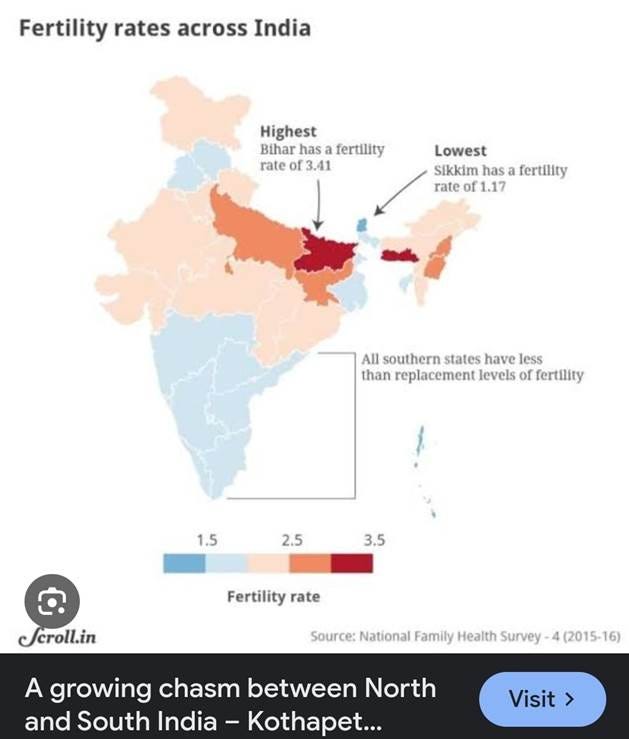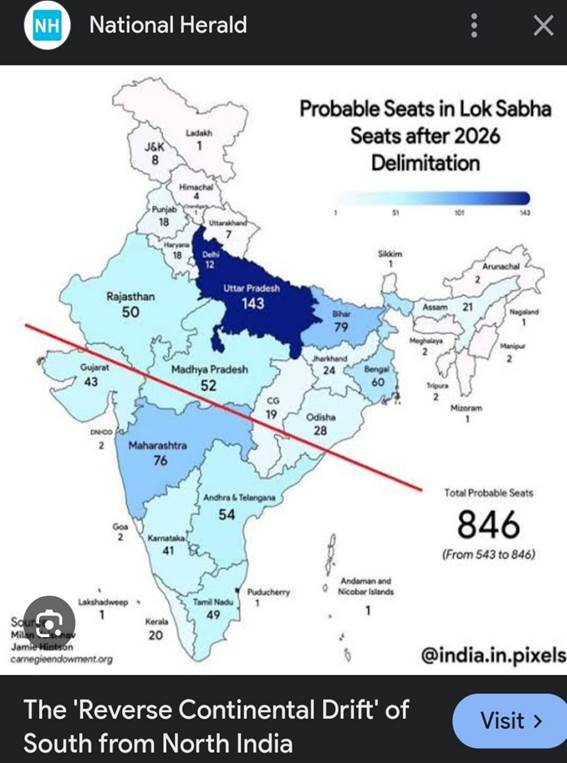A Turn in the South
12/03/2025
This is not a post about investing. If you are only looking for investing related posts, and are not interested in India, please feel free to ignore it.
I recently spent three weeks travelling in southern India and this article was inspired by my trip.
I travelled for three weeks going through three states- Karnataka, Tamil Nadu (TN) and Kerala and a few cities and towns therein.
India is of course a vast diverse land, more (sub) continent rather than country. The South is materially different from the North. One of the key sources of differences is economic. Prior to the trip, I heard a podcast where the speaker quoted some statistics about the “Peninsular States” (see map below.) These are the states we visited plus Andhra Pradesh (including Telangana).
In 2014, the state of Telangana was carved out from Andhra Pradesh. The map above dates from 2011 and shows the pre-split Andhra Pradesh.
The key data quoted in the Podcast were as follows:
The Peninsular States plus Maharashtra account for a third of India’s population but they account for 50% of its GDP and 65% of the incremental GDP.
In other words, the average person in the South is much richer than the average Indian and the gap is increasing This suggests the South has done some things right which the rest of India could perhaps emulate.
The average all-India GDP per capita is US$ 3050 (GBP 2440).
The per capita GDP in the southern states is well above this. Goa, which is part of the South is so many ways, is the second ranking highest state in terms of per capita GDP. Gujarat and Maharashtra are also above average.
The average is dragged down by the large, so-called, BIMARU states – these are Bihar, Rajasthan, Madhya Pradesh and UP. UP and Bihar have a combined population of 350mn (more than the US!) but a per capita GDP per head lower than Zambia, Benin or Tanzania.
The map above shows the state wise percentages of poor people. On the chosen definition of poverty, the Kerala poverty rate is below 1%. In Tamil Nadu it is below 5%. In contrast, it is above 35% in some large northern states and over 50% in Bihar. ( (implies 60mn poor people in Bihar ).
Karnataka
We started our trip by flying into Bangalore (or Bengaluru as it is now known). It was once known as the Garden City of India due to the many parks in the city. It had a pleasant climate and was a city that middle class people chose to retire to.
Bangalore is a major educational hub. Its many schools and universities including the prestigious Indian Institute of Science (IISc) and the Indian Institute of Management (IIM-B).
Some large public sector companies have been headquartered there for decades. these include Hindustan Aeronautics (HAL), Bharat Earth Movers Limited (BEML) and Bharat Electronics.
From the 1990s, the Information Technology boom hit Bangalore, and the city started to grow very rapidly. Foreign and Indian IT companies set up shop there in large numbers. Two Indian companies we have covered, Infosys and Wipro are headquartered in Bangalore.
Bangalore Skyline
Infosys HQ in Bangalore.
World Trade Centre Building – Bangalore
People have moved there from all over India and the city has developed rapidly. Its infrastructure hands become strained. Traffic jams are terrible even by Indian standards. Trees and stretches of greenery have been lost and the mild climate has changed for the worse. As of 2023, Bangalore had an estimated GDP of $359.9 billion which implies a per capita GDP of $ 24,000. This is 8X higher than the India average and in line with Greece and Hungary.
This video gives you
Bangalore, often referred to as the "Silicon Valley of India," has an economic base rooted in Information Technology (IT), Biotechnology, Aerospace, Telecommunications, Electronics and Manufacturing Sectors. The city is also emerging as India’s major hub for Electric Vehicle (EV) design and manufacturing.
Additionally, Bangalore is a global hotspot for Global Capability Centres (GCCs), housing over 40% of India’s GCCs. These centres, established by multinational corporations, leverage Bengaluru's tech-savvy workforce, advanced infrastructure, and robust innovation ecosystem to manage critical operations, including R&D, IT support, finance, and customer services for the parent company’s global operations.
Prominent firms like Microsoft, Google, Goldman Sachs and Shell operate large-scale GCCs in Bangalore, driving global innovation and operational efficiency. The presence of these centres has significantly contributed to the city’s reputation as a preferred destination for offshore innovation and strategic business support.
Biotechnology is also an important sector in the city with about 60% of all Indian biotechnology firms located here.
The city is also called the aviation monopoly capital of India. It accounts for more than 65% of India's aerospace business. World Aerospace giants such as Boeing. Airbus, Dynamatics, Honeywell, GE Aviation, United Technologies and others have their Research & Development and Engineering centres. The city contributes over 44 % to the economy of Karnataka, accounting for 98% of the state’s software exports.
Nearly 56% of the workforce in Karnataka is engaged in agriculture and related activities. It means there is a sharp economic urban /rural divide and very different income levels.
Tamil Nadu
From Bangalore, we took an 8-hour train ride, travelling southwest to the city of Coimbatore, which is the second largest city in the state of Tamil Nadu (TN). The largest Tamil Nadu city is Chennai and it is on the eastern coast.
Coimbatore is a blue-collar city and a hub for Textiles, Engineering including Textile Machinery. It is also referred to as "the Pump City" as it supplies nearly 50% of India's motors and pumps.
Coimbatore is called the "Manchester of South India" due to its extensive textile industry, fed by the surrounding cotton fields.
One of the textile companies of Coimbatore is KPR Mills which today has a Market Capitalisation of $3.2bn. This is a remarkable company led by Chairman KP Ramasamy (KPR).
KP Ramasamy Chairman of KPR Mills who is a noted and effective philanthropist.
The Head of HR of Infosys explains the story of KPR most succinctly. He was invited to make a speech at a special graduating ceremony in Coimbatore at KPR. It was a convocation held for women workers employed at KPR. This was his speech which I reproduce in full below:
“I have witnessed many welfare programs, higher education assistance for employees from some big brands across the world. In all these programs, there will be an underlying statement - what will the employee give back to the company?
We keep reading about some brilliant case studies across the globe but trust me, nothing will come close to what KPR Mills is doing for its employees. It's a silent revolution that their Chairman KP Ramasamy has taken upon. It was a chance encounter several years back when he was interacting with his women employees on what they want as a welfare program. A young girl said “Appa (father as the girls call him), I want to study. My parents pulled me out of school to join this Mill due to poverty, but I want to study further".
This request left a lasting impression upon him and hence he decided to provide higher education assistance, completely free of cost. The girls work on a 8-hour shift and those interested can study further for 4 hours every day. Classroom facilities, full-time teachers, an exclusive principal for this program, Computer Lab and a Yoga course are all provided to run this program effectively.
Now here's the staggering numbers - In the last several years, over 24,536 girls have finished their 10th, 12th, Undergraduate and Postgraduate courses.
They have their alumni in almost all hospitals where the girls are working as Nurses. Others are school teachers, some have joined the Police force and the list goes on and on. Yesterday in the convocation over 350 girls received their degrees and out of which 20 of these girls are TN Open University Gold Medallists.
Now the natural question kicks in right - When companies are battling attrition issues, if we provide free higher education, won't the girls quit and that will result in high employee turnover. Mr Ramaswamy has an answer.
He says " I don't intend to keep them in the Mill and waste their human potential. Many of these girls are smart and have landed here due to poverty. My job is to ensure that they get a good degree, get required skills and settle well in life. When these girls leave the Mill, they also refer girls from their Village and that cycle continues. Human resource is precious and we need to leverage it effectively".
What profound thoughts and he simply nailed it....this is what true Human Resource Development is all about. As I finished my address and took my seat, the Chairman held my hands and said "Sir, I normally don't ask for favours and have never asked anything for my students studying in my college but these girls are special. There are girls who have completed B.comm, MBA, M.comm and several other courses. If you or your friends can hire them...it will give other girls a lot of hope to study further.Can you please help".
I was like dumbstruck... here's a man who runs a multi-crore turnover successful business and he is asking help to place his own employees - Have you heard something like this? Friends....these are stories that the world needs to know...these are case studies that the Business schools needs to teach their students and HR professionals need to learn. If you are looking for potential hiring, then you might want to consider KPR Mills and I am sure you will not be disappointed. Some of the most inspiring stories comes from unknown quarters and KPR Mills and their social revolution through education is a story that needs to spread like wild fire. It was a Sunday where I came back inspired.”
Mill Land belonging to one of the largest Coimbatore Textile companies, Lakhsmi Mills has been converted to a modern shopping centre.
Coimbatore is also well known for the headquarter of the Isha Foundation. it is located outside the city with the picturesque Western Ghats.
Tea Plantations in the Western Ghats
Giant Shiva Statue at the Isha Foundation in Coimbatore.
The Isha Foundation attracts middle class Indians and tourists for residential courses in meditation, Yoga and so on.
Tamil Nadu Politics
Coimbatore is in Tamil Nadu (TN). I want to spend some time talking about the politics of the TN. Nationally, the political rivalry is between a dominant BJP party and a faltering, weakened Congress. However, in Tamil Nadu, neither of the parties is in the picture. We need to go back perhaps 60 years to understand why.
The Indian Constitution, adopted in 1950, under article 343, declared that Hindi would be the official language of India and English would serve as an additional official language for 15 years until 1965. In 1965, the attempt to impose Hindi was met by protests including in Tamil Nadu, Karnataka and Andhra Pradesh. In TN, this led to violent protests and 150 died before the government agreed that Hindi would not be the sole national language of India.
Protestors against the imposition of Hindi in 1965.
"I plan to die in order to protect Tamil. One day, my goal will be met," wrote a 27-year-old man called Chinmasami from Tiruchi in a note he left behind before setting himself on fire in protests against Hindi imposition in TN in 1965.
It might seem strange that people are willing to die for a language. However, it is important to understand how closely bound up identity and language are in Southern India. The southern languages are Dravidian languages. Today these are found mainly but not exclusively in the South. Dravidian languages have different roots from the main body of Indo-European languages. The latter is a heterogenous group which includes Hindi, Bengali, French German Spanish and English among others.
Dravidian languages much older and have a completely separate history and script to Hindi and other North Indian languages.
From a southern perspective, Hindi is seen an alien language which would be difficult for southerners to learn. It is understandable they resisted the attempt imposition of Hindi as National language in 1965. It would be like the Italians being force to speak Danish. In fact there are more similarities between Danish and Italian (both Indo-European languages) than there are between Hindi and Tamil.
The language protests in Southern India are not simply a footnote of history but a live current issue. The Indian government’s National Education Policy (NEP) 2020 proposes a three-language formula as it mandates students learn their regional language (mother tongue), Hindi and English. Tamil Nadu is refusing this as they do not want Hindi to become a compulsory language in schools. The central government is threatening to withhold funds from TN.
This is a live issue with a long history.
The Congress-led central government in the 1960s were identified as pro-Hindu and therefore anti-Tamil. Congress lost power in TN in 1967 and have not been in contention since. Since then, politics in TN has been a two-horse race between two Dravidian Parties, the DMK and AIADMK which split away from the DMK in 1972. BJP and Congress have had a negligible presence.
The Dravidian movement is little understood outside the south, even in the rest of India. The Dravidian identity is both a linguistic, cultural and regional identity.
It sprang from the efforts of the radical social reformer Periyar, who promoted the principles of rationalism, self-respect, women’s rights and eradication of caste. He opposed the exploitation and marginalisation of the non-Brahmin Dravidian people of South India and the imposition of what he considered Indo-Aryan India. He grew disillusioned with Hinduism and became an Atheist.
All Dravidian Parties claim descent from his movement and allegiance to his beliefs. Dravidianism constitutes a politics that privileges social justice, opposes caste, promotes a culture of rational debate, and upholds local linguistic and regional concerns over all else.
Two Dravidian parties have taken turns at ruling Tamil Nadu in the last 50 years—the DMK and the AIADMK. They have not proven immune been exempt from the curse of corruption and exploitation.
However, both parties have implemented many progressive policies which the country nationally did not adopt for another 10-30 years.
For example, the mid-day meal scheme in school was introduced in 1920s and expanded greatly in the 1950s. This boosted school attendance and helped to boost literacy which is now estimated to be 83%. The state has one of the highest enrolment to secondary education at 95.6%, far above the national average of 79.6%.
Higher Education Enrolment has reached 51% and the TN Government hopes to increase it to 75% in next 5 years. Tamil Nadu's schools’ Gross Enrolment Ratio (GER) is twice the national average and is on par with developed nations.
The performance of local officials in TN is judged among other things on their record in reducing school non-attendance as the above newspaper article notes.
As any drive on a major road in TN will show, there are many private engineering colleges. There are 510 engineering colleges including 34 government colleges in the state. There are over 870 medical, nursing and dental colleges in the state.
Tamil Nadu has focused on reducing poverty and enhancing social welfare through initiatives like the noon meal scheme, which have contributed to high human development indicators.
Tamil Nadu has also emphasised industrial development with a decentralized industrial model. There has been a focus on clusters and Special Economic Zones (SEZs) across different sectors like textiles, automotive, engineering and IT. Foxconn is assembling Apple iPhones while a Tata plant doing the same is in Karnataka. It is estimated that 40% of all female factory workers in India are in TN.
The TN Model of Development emphasizes social justice, equality, and inclusive growth. It has its roots in the Dravidian movement, which sought to address caste-based inequalities and promote regional identity. Academic Christoph Jaffrelot has studied development in Bihar, Gujarat and Tamil Nadu. He made the following observation.
“When you compare Gujarat and Tamil Nadu you find that Gujarat is very similar to Tamil Nadu in terms of infrastructure and industry. It is doing better (than Tamil Nadu) in terms of electricity production and roads. Roads are probably what Narendra Modi invested in the most as chief minister. But Gujarat is close to Bihar in many respects including malnutrition, poverty gap-the rate of people living below the poverty line. Rate of education is not great at all, at least English medium education is very poor. It is interesting to see that if there is a model in India today it is Tamil Nadu. Here is a state that has almost eradicated poverty, industrialised at a high pace and where services are taking over from industry. This is something you don’t see in Gujarat.”
Kerala
After Coimbatore, we drove to the Coastal state of Kerala.
Economists argue that China (rightly) focused on basic primary healthcare (e.g. Mao’s barefoot doctors) and mass school education while India made the mistake of focusing in elite education for a favoured few ( e.g. Nehru’s IITs). If this is true, there is one exception to this, the state of Kerala. The state has pursued radically different policies compared with most of India, especially the north and this has been dubbed the “Kerala model of development.”
In 1957, a communist-led government under E. M. S. Namboodiripad (EMS) won the first ever elections for the new Kerala Legislative Assembly. EMS was the first communist leader in India to head a popularly elected government. It was only the second ever Communist government to be democratically elected, after the Republic of San Marino in 1945. Today, politics in Kerala is a contest between Congress and the Communists. The BJP has little support.
In 1957 the Kerala government introduced Land reform laws and progressive Education Bill. Frome the late 1950s, Kerala was spending about 35% of tits expenditure on education compared with the all India average of under 20%.
In 2006–2007, the state topped the Education Development Index (EDI) of the 21 major states in India. As of 2007, enrolment in elementary education was almost 100%; and, unlike other states , educational opportunity was almost equally distributed among sexes, social groups, and regions. According to the 2011 census, Kerala has a 93.9% literacy, compared to the national literacy rate of 74.0%In January 2016, Kerala became the first Indian state to achieve 100% primary education.
The people in the North get less education than those in the South. In addition, there are important differences in what they study. In the North students studying beyond Class 10 are in the humanities channel tend to study humanities. The all-India average is 40.1 %. It is much lower in the southern states (4.7% in Andhra Pradesh and 7.3% in TN).
On the other hand, 19% of post Class 10 students in India study technical subjects. In the southern states, it is between 35% and 43%. This is important as the latter tend to lead to more remunerative careers.
The people in the North get less education than those in the South and the gender gap in education is much greater in the North. Poor girls in the North are likely to be most disadvantaged group.
Education of girls is highly correlated with the fertility rate and population growth. There have been a lot of studies showing the close relationship between the number of years in education and the marriage age and the fertility rate.
The chart above shows the stark differences between the South and the North esp. Bihar and UP. The southern states all have a fertility rate below the replacement rate of 2.1. If it was not for migration (from the North), the population of the southern states would be falling. This is also related to gender ratios. These tend to be higher in the South as shown in the map below.
Other policies initiated by the Kerala government included
a land reform initiative that abolished tenancy and landlord exploitation though many landowners lost ancient property and became paupers overnight
effective public food distribution that provides subsidised rice to low-income households.
protective laws for agricultural workers; pensions for retired agricultural labourers; and a
high rate of government employment for members of formerly low-caste communities.
In Kerala, services account for about 63% of its revenue. These is mainly based on sectors such as hospitality, tourism, medical services, pilgrimage tourism, IT, transportation, financial sector, and education.
The primary sector (including fishing and agriculture) accounts for only 8% though they a significant employer.
Kerala's economy depends significantly on emigrants working in the Arab states of the Persian Gulf. The state witnessed significant emigration during the Gulf Boom of the 1970s and early 1980s and this continues today. Foreign remittances contribute more than a fifth of state GDP. Typically, a person may spend a decade or more in the Gulf. When they come back, they invest money in land, property and gold.
Poverty has been reduced, and Kerala’s income/wealth inequalities are probably much lower than the rest of India. However, communism has also given rise to strong union rights and Kerala has a reputation for militant labour. Industrial investment has been low, and this has led to subdued economic growth and job creation.
It could be argued that Kerala has put so much emphasis on social issues and labour rights they have discouraged industrial investment while Tamil Nadu has taken a more balanced approach between the two.
This means the poverty rates are lower in Kerala, but economic growth and industrial investment and employment is higher in TN.
Delimitation
Tamil Nadu and other southern states have done the right thing. they curbed their population growth while focusing on education and healthcare, leading to improvements in social and economic indicators. In contrast, the Northern states generally have not done the right thing.
India's constitution mandates that a redrawing of parliamentary constituencies must commence by 2026, and analysts say this will be necessary to ensure fair representation in legislatures and to keep pace with demographic change. The current constituency borders which are based on the population levels fifty years ago. The population in the North since then has grown much more than in the South. The number of constituencies have to be increased and this process is called delimitation. They have to rise from 543 to 846. The bulk of the increase will come in the North.
This means politics will punish the Southern states which have done the right thing as they will get few new constituencies while the Northern states will get many new constituencies. As the BJP is dominant in the North and has little support in the South, delimitaton will benefit them.
A fresh seat reallocation would disproportionately shift power towards the Hindi heartland, weakening the delicate federal balance.
Three dozen political parties in TN buried their differences to jointly opposed delimitation.
Modi's Bharatiya Janata Party (BJP) has accused leaders in the south - where opposition parties hold power - of playing politics and inflaming the north-south divide. Politicians in the south, for their part, fear a power grab by the BJP and say their grievances transcend politics. This is an important current issue.
Summary
We recently took a driving holiday through Southern India. Even though it was a very quick visit, it was clear that Southern India differs greatly form the north. On our return, we decided to do some desktop research which confirmed that this is the and provided some interesting data to support this observation.
The south has much higher living standards and GDP per capital in the north. They are also states where the BJP which dominates the national government has the least support.
Education levels are much higher, poverty levels are higher and development indicators are better.
What accounts for the difference? We do not have any expertise in development economics and are not able to give definitive answers.
However, we can speculate as to some of the reasons why the South is so much better off than the North.
Historically, part of the south had native kingdoms and rulers where more progressive educational and social policies were pursued.
The Church under the British was very active in the south and they set up many schools and colleges as well as clinics and hospitals. Importantly, many of these taught in English.
Many local businessman, rulers and philanthropist also set up charitable institutions in health and education and engaged in progressive social work.
Land reform in Kerala helped to reduce economic inequality. They had communists but that is just a name. Like the communists in Cina since 1979, they focused on development and achieved results.
In Tamil Nadu, Dravidian parties pursued policies which aggressively promoted affirmative action and Reservation. These favoured poor castes and discriminated against the Brahmin elites. The latter suffered greatly, and many migrated to Mumbai and abroad. However, these policies significantly reduced inequality.
Tamil Nadu governments have actively encouraged industrial development, and this has contributed to the strong growth enjoyed by the state in recent years.
The IT boom since the 1990s helped Bangalore, Hyderabad and Chennai economies. The IT industry was in part attracted to the south due to the well-developed scientific education tradition.
Kerala has benefited significantly due to the Gulf boom of the last fifty years.
12/03/2025


